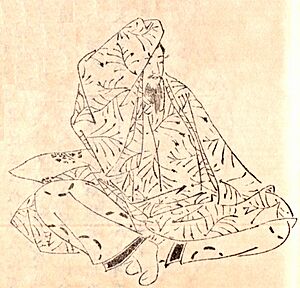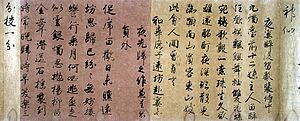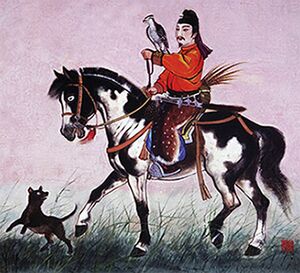Fujiwara no Yukinari facts for kids
Quick facts for kids
Fujiwara no Yukinari
|
|
|---|---|

Portrait by Kikuchi Yōsai
|
|
| Born | 972 |
| Died | 3 January 1027 |
| Nationality | Japanese |
| Occupation | Calligrapher |
|
Notable work
|
Three Brush Traces |
Fujiwara no Yukinari (藤原 行成, 972 – January 3, 1027), also known as Fujiwara no Kōzei, was a famous Japanese calligrapher during the Heian period. He was so skilled that people remembered him as one of the "Three Brush Traces" (Sanseki). The other two were Ono no Michikaze and Fujiwara no Sukemasa.
His Life
Fujiwara no Yukinari's father was Fujiwara no Yoshitaka, who worked for the emperor's court. When his father died young, Yukinari was raised by his grandfather, Prince Kanenori.
Yukinari had a very successful career as a court official. He even served as a "Major Counselor," which was a high-ranking job.
Yukinari made Japanese-style calligraphy, called wayō-shodō, even better. He really looked up to Ono no Michikaze, who started this style. In his diary, Gonki, he wrote about a dream where he met Michikaze and learned from him!
Yukinari was especially good at writing kana, which are Japanese characters. His writing style was gentle and easy to copy. His lines were delicate and beautiful, making his characters very elegant. Fujiwara no Yukinari is seen as the founder of the Sesonji calligraphy style. This style later became the most important way of writing wayō calligraphy. Most of his surviving works are written using Mana (Chinese characters used for their meaning) in either Gyōsho or Sōsho styles.
His Works

One of his most famous works is a long handscroll of eight poems by Bai Juyi. He created this amazing piece in 1018 when he was 47 years old. The scroll was made by joining nine pieces of special paper called ryoshi. These papers were dyed in colors like light brown and claret.
Emperor Fushimi (who ruled from 1288 to 1298) really valued this handscroll. A special note, called a colophon, on the back of the paper shows this. Today, the scroll is kept at the Tokyo National Museum. Yukinari also left behind his diary, Gonki, and a recently found book of ceremonies for yearly events called Sinsen Nenchugyoji.
See also


